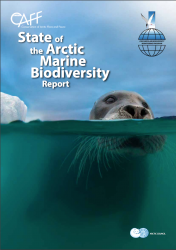Our Archive
The reports featured here are central to our work. Additional reports can be found using our search function.
Reports by CCU
State of the Arctic Marine Biodiversity Report
This State of the Arctic Marine Biodiversity Report (SAMBR) is the first integrated reporting outcome from the Circumpolar Biodiversity Monitoring Program (CBMP). The Arctic Biodiversity Assessment (ABA) (Meltofte 2013) provides the fundamental baseline to make trend assessments in…
Reports by Arctic Council
Arctic Biodiversity Assessment: Marine Ecosystems Chapter
Arctic marine ecosystems host a vast array of over 2,000 species of algae, tens of thousands of microbes and over 5,000 animal species, including unique apex species such as the polar bear (Ursus maritimus) and narwhal (Monodon monoceros),…
Arctic Biodiversity Assessment: Disturbance, Feedbacks and Conservation Chapter
Humans disturb the environment in various ways, notably from industrial development and other activities in formerly pristine areas. Components of the earth system affect one another in a web of feedbacks, including between ecosystems and climate. Conservation is…
Teacher Resources

Arctic School Garden Project
The Arctic Council has developed educational guides and manuals around the Arctic ecosystem. These resources are available to the public and are a useful teaching tool for grade school students.





